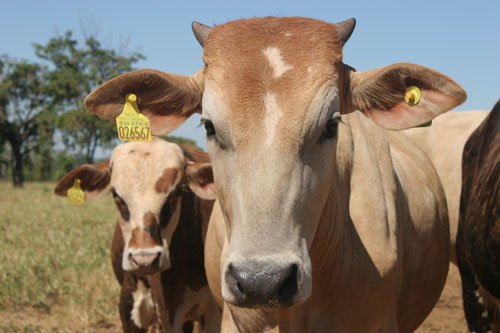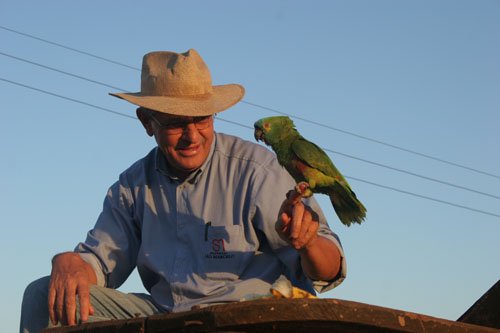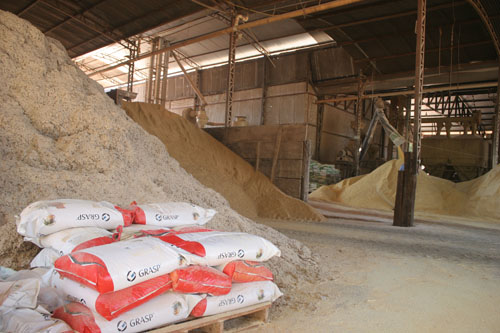Brazilian cattle ranching and sustainable certification: opportunities and barriers
CCAFS researchers, together with Masters students from University of Michigan, recently visited cattle ranches in Brazil. Together they are exploring opportunities and barriers to producer participation in the Sustainable Agriculture Network’s Rainforest Alliance Certification.
As we approached the farm, Toninho pointed to a large tree and said, “this tree was a sapling when I was a boy”. Every year he comes back to the tree to take a picture with this relic of his childhood. It was at this moment that I realized just how deeply cattle ranching is embedded within the culture of Brazilian ranchers that spend their lives in this work.
Toninho is the farm manager at Fazenda Sao Marcelo (SM) near Tangará da Serra, a small farming city in Mato Grosso—the state in Brazil where cattle ranching is most prevalent. SM is the first ever Rainforest Alliance certified cattle ranch in the world and will hopefully pave the way for many other farms to certify as well. For two days, CCAFS researchers and Master students from the University of Michigan’s School of Natural Resources and Environment were guests at SM.
The master’s students were in Brazil this August to investigate the sustainability of the cattle ranching industry while examining the opportunities and barriers to producer participation in the certification program.
Ben and Helena talking with Toninho (from left to right).
Why certification? First things first, how about a brief background on the history of cattle ranching in Brazil? The famous Nelore cattle breed was brought over to Brazil in the late 1800s from India and has been bred in the country ever since. In the mid 1900s, the Brazilian government attempted to stimulate economic growth by enabling the people of Brazil to have easier access to land for agriculture. So… they began building networks of roads from coastal cities into the western region of the country. Furthermore, they encouraged people to deforest land and start producing. Cattle have both the lowest cost and risk of any of the agricultural commodities since they are less sensitive to drought and other disruptions in weather or food source than are other crops, so many new farmers went for this option.
In order to set up a cattle farm, a farmer had to find a plot of land, deforest it, and allow the cattle to graze. Relatively simple, it seems. Once the land had been degraded by years of cattle feasting upon the grass and trampling over head waters and streams that may be situated on the land, the farmer simply found a new plot of land and began the process over again. This was a characteristic practice that went on for decades without much concern. The country’s economy was growing and the farmers were producing. Brazil, arguably, would not be in the economic state it is in today without this growth.
However, the national cattle herd grew fast (it was 212 million in 2011), and concerns about deforestation and pressures from non-governmental organizations (NGOs) from both within the country and outside began pouring in. In 2009, Greenpeace released an article entitled “Slaughtering the Amazon”, which cited cattle ranching as the biggest driver of deforestation in Brazil.
A young Nelore hybrid in its early stage of growth on the pasture.
Now back to certification… Until recently, there was no third party certification program for beef in Brazil, which is why the Rainforest Alliance certification program may be able to have a large impact on the sector. The program sets higher standards for environmental and social sustainability than any existing law or incentive program in Brazil. The criteria that certified farms must adhere to address issues such as deforestation, watershed protection, and animal welfare.
Even before certification, SM was extremely progressive in the way the company manages the farm. They excel in the environmental, the social, and the financial when it comes to the triple bottom line. Their animal welfare standards go above and beyond in comparison to most of the rest of the industry, but their human welfare also tops anything that other farms have in practice. They started a number of projects to educate and prevent child and forced labor. SM also ran a project called “Projetos Asas” in which they rehabilitated wildlife on the farm, such as parrots and other exotic animals, to prepare them to be released back into the wild. One of the parrots even stayed around the farm and is a permanent resident.
Toninho, the SM farm manager, holding the (now) resident parrot from Projetos Asas.
SM is extremely advanced in the way the farm is able to grow cattle and it shows when examining the number of head of cattle per hectare they are able to produce. Currently, SM is able to produce 1.3 animal units per hectare, whereas the national average is 0.7. Their high productivity is a consequence of their progressive management, which includes implementation of the feedlot. The feed for the cows in the last stage – the fattening stage –includes sugar cane, cottonseed, corn, and minerals, and is meticulously measured out and mixed. The measurements of feed change depending on how quickly the cows are gaining weight, which is also closely monitored and displayed in dozens of graphs on large pegboards in the office.
The warehouse where the feed is stored, measured out and distributed to the cows. From left to right are minerals, cotton seed, and ground corn kernels.
When touring the farm, we were able to see the different facets to cattle production. Sao Marcelo houses many stages of the cycle – from birthing calves to sending the full-grown cattle to slaughter. Additionally, they participate in genetic selection, which involves choosing male cows, or bulls, from the herd that show desirable characteristics, such as good temperament, steady and evenly distributed weight gain, and overall good health. They take samples of the sperm from these superior bulls and test it to make sure it is fertile and the bulls are healthy. Once they pass this testing, the bulls are sold to other farms for breeding at premiums to create the next generation of Nelore cattle.
The next steps…80% of beef produced in Brazil is currently consumed domestically in Brazil. However, consumers aren’t yet aware of the progressive production practices employed by certified farms in the cattle sector and no price premium exists for sustainable or ethically-produced meat. This makes farmers hesitant to certify. There is no certainty that they will get a direct financial return on investment if they move forward with certification. However, the good practices that certification enforces result in higher yields, which is a direction in which the Brazilian cattle sector is moving as a whole.
Commodity certification has been shown to have an impact elsewhere, but the cattle chain is uniquely complex and poses additional challenges. Should certification succeed in this sector, it will be a huge accomplishment for the Sustainable Agriculture Network and for Brazil.
By Melisa Ongun – University of Michigan Masters Student
Photos: Pete Newton
News
IFRI Special Issue Collaboration
(17/09/2016)
FLARE Announces Keynote Speakers





